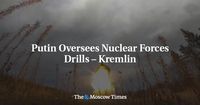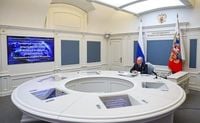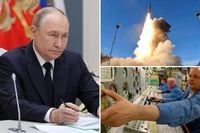On October 22, 2025, the world watched with keen interest as Russian President Vladimir Putin oversaw a sweeping readiness test of his nation’s strategic nuclear forces—a display that reverberated far beyond the borders of Russia. The drills, which unfolded across land, sea, and air, were described by the Kremlin as a planned exercise, yet the timing, coming just a day after a highly anticipated summit between Putin and U.S. President Donald Trump was abruptly shelved, was difficult to ignore.
Putin, addressing his top military brass via video conference, made a point to stress the routine nature of the exercise. “Today, we are conducting a planned — I want to emphasize, planned — nuclear forces command and control exercise,” he said, according to CNN. The maneuvers involved the full might of Russia’s nuclear triad: a Yars intercontinental ballistic missile (ICBM) was launched from the Plesetsk Cosmodrome in the country’s north, a Sineva ballistic missile was fired from the Bryansk nuclear-powered submarine stationed in the Barents Sea, and Tu-95MS long-range bombers released air-launched cruise missiles. The entire operation, as reported by Reuters, was designed to test the preparedness of Russia’s military command and the practical skills of its operational personnel in controlling subordinate forces. The Kremlin later announced that “all exercise tasks were completed.”
These drills, though described as routine, carried a distinct message. According to the Associated Press, the exercise “tested the skills of military command structures and procedures for authorizing the use of nuclear weapons.” General Valery Gerasimov, chief of the military’s General Staff, reported to Putin that the drills specifically practiced procedures for authorizing nuclear weapon use—a chilling reminder of the stakes involved. Putin, Defense Minister Andrei Belousov, and Gerasimov, all appeared on screens together during the exercise, underlining the chain of command that would be activated should Russia ever consider deploying its nuclear arsenal in conflict.
But the geopolitical context was impossible to ignore. Just hours before the drills commenced, President Trump had announced that his planned summit with Putin in Budapest was being put on hold. “I didn’t want it to be a waste of time,” Trump said, as quoted by multiple outlets including CNN and the Associated Press. The meeting, which had been arranged to discuss the ongoing war in Ukraine, was called off after a call between U.S. Secretary of State Marco Rubio and Russian Foreign Minister Sergey Lavrov. Lavrov, for his part, made clear that Russia was opposed to an immediate ceasefire in Ukraine, a stance that further complicated any prospects for peace.
The White House’s decision to postpone the summit left the diplomatic landscape in limbo. Kremlin spokesman Dmitry Peskov emphasized that such a high-level meeting “needs to be thoroughly prepared,” telling reporters, “No one wants to waste time: neither President Trump nor President Putin. These are the two presidents who are accustomed to working efficiently with high productivity. But effectiveness always requires preparation.” As of October 22, 2025, the White House stated there were no immediate plans for Trump and Putin to meet, according to Newsweek.
The nuclear drills themselves were not the only show of force in the region. Earlier in October, NATO carried out its own annual nuclear exercises, known as Steadfast Noon. According to CNN and Reuters, more than 70 aircraft from 14 allied nations—including F-35A fighter jets and B-52 bombers—participated in drills hosted by Belgium and the Netherlands. NATO Secretary-General Mark Rutte explained the rationale behind these exercises: “We need to do this because it helps us to make sure that our nuclear deterrent remains as credible, and as safe, and as secure, and as effective as possible.” The alliance stressed that Steadfast Noon was “not linked to any current world events,” but the proximity in timing to Russia’s own maneuvers did not go unnoticed.
Russia, for its part, often frames these exercises as a necessary rehearsal to keep its vast nuclear arsenal—the world’s largest, as Reuters and the Associated Press both note—in peak readiness. The Kremlin’s statement following the October 22 drills highlighted the importance of maintaining operational skills and command-and-control systems. “All objectives were met,” the Kremlin said, underscoring the technical success of the operation.
Beyond the immediate military posturing, the nuclear landscape is also being shaped by looming questions about arms control. The New Strategic Arms Reduction Treaty (New START), which limits both the U.S. and Russia to 1,550 deployed warheads and 800 launchers and bombers, is set to expire on February 5, 2026. Signed in 2010 by then-U.S. President Barack Obama and Russian President Dmitri Medvedev, the treaty has long served as a cornerstone of nuclear arms limitations. Last month, Putin signaled his willingness to support a one-year extension of New START if President Trump agreed, as reported by the Associated Press and CNN. But with diplomatic relations strained and no summit in sight, the fate of the treaty remains uncertain.
Russian Deputy Foreign Minister Sergei Ryabkov warned on October 22 that if the U.S. rejects the New START extension proposal, “there will be a total vacuum in the area of nuclear weapons limitations and a growing nuclear threat,” according to RIA Novosti and CNN. “Russia must be convinced of the U.S. administration’s sustainability in abandoning its hostile course,” Ryabkov added, highlighting the deep mistrust that lingers between the two nuclear superpowers.
The cancelled Trump-Putin meeting also underscored the diplomatic impasse over Ukraine. According to Newsweek, Russia reiterated its peace terms, insisting that Ukraine must give up the entire Donbas region—a direct rejection of Trump’s earlier suggestion that the current battle lines could serve as the basis for a peace settlement. Trump, after meeting with Ukrainian President Volodymyr Zelensky, insisted there had been no discussion of Kyiv ceding the Donbas, but acknowledged that “the war should just stop at the lines where they are—the battle lines.” Such a proposal would leave Russia in control of significant swathes of Ukrainian territory, a position Kyiv has repeatedly rejected.
As tensions simmer, both sides appear to be digging in. Russia continues to flex its nuclear muscle, reinforcing its deterrent and sending unmistakable signals to both NATO and Washington. The U.S. and its allies, meanwhile, are doubling down on their own readiness and commitment to Ukraine’s sovereignty. With the New START treaty’s expiration looming and diplomatic channels faltering, the risk of miscalculation—or simply misunderstanding—remains ever-present.
For now, the world is left to watch, wait, and hope that cooler heads prevail. The choreography of missile launches and military exercises may be routine, but the stakes are anything but ordinary.


